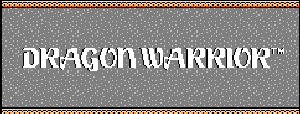|
Thou shalt embark upon a most amazing adventure full of monsters and demons, on a quest to save thy dear Princess Gwaelin. As the championed descendent of Erdrick, it is thy destiny to defeat the DragonLord, thus bringing peace and light to the kingdom of Tantegel. With the creation of Japan's Dragon Quest (and subsequently Dragon Warrior for American audiences), a revolutionary line of truly classic RPGs was born, setting the tone and theme for many others to come.

Tantegel, Brecconary & Charlock | |
With a large overworld waiting to be explored and dark, creepy underground labyrinths to stumble through (don't forget a torch!), the original Dragon Warrior offers an adventure seemingly identical to the original Zelda. However, a closer look at the series proves that while they share a few key ideas, on the whole they're vastly different. In contrast to the action type battles in games like Zelda, Dragon Warrior is one of the first games to feature a menu based style of combat. Battles aren't carried out with a camera sitting off to the side, though -- enemies approach from head-on in a first person perspective. (A slime is approaching!) Along with the "fight" command, the hero can run, use an item, or cast a spell, and with every battle experience and gold is gained. Dragon Warrior is remarkably infamous for the many hours of random fighting necessary in order to gain the gold needed to purchase the next level of powerful equipment.

Gaining a Level | |
Walking in circles to fight the exact same enemies for hours on end was great entertainment in those days. RPGs of lore were rarely concerned about plot and characters, as later games are. The simple thrill of exploring and adventuring was a concept new enough to game players to keep them hooked. "Can I strike just one more time before healing or will the enemy's next blow demolish me?" one would often wonder. Each level gained offered a few more HP and MP, attack and defense points, as well as the occasional spell. Some spells could illuminate a dungeon, repel enemies, or warp you back to Tantegel Castle. Of course, the most useful and creatively titled spells were certainly Heal and Healmore, and their counterparts Hurt and Hurtmore. Patience, time and perseverance could very well be the motto of Dragon Warrior, as experience levels proved to be the most important factor in advancing through the game.

The town of Garinham | |
Along the way were towns to visit -- always few and far between, but filled with clues and secrets to help the hero if he didn't know where to turn next. In each town could be found the traditional inn, as well as armor shops with equipment upgrades, and tool shops that sell herbs and torches, and later on, stores that sell magic keys. When not fighting, gamers can click into the menu to check status, talk, take items, use items or spells, climb stairs or open doors, and search the ground around them. Out in the world, knowing one's enemies is essential to staying alive. Some can be put to sleep, and some are not vulnerable to magic at all. If the hero dies, the king will always revive him -- but he loses half of his gold, so many times resetting is a better option. Of course, frequent saving is the best way to protect hard earned gold and levels.
| | 
Inside a cave |
Though the game might seem repetitive at times, there really is a plot and certain goals that have to be met before the hero can take on the DragonLord. A rainbow bridge is needed to reach the castle, which could only be created by combining the Stones of Sunlight with the Staff of Rain (more wonderfully creative titles). To obtain the Staff of Rain you had to give an old man the Silver Harp, and to get the Stones of Sunlight you had to find a shop with magic keys, and so on and so forth. In a small plot twist, the Princess hasn't been kidnapped by your final enemy, the DragonLord, but by a plain green dragon in the swamp cave. After rescuing Gwaelin, she bestows her love upon you (and begs you to marry her), which seems trite and silly, but turns out to be the only thing that leads you to Erdrick's token, another item essential to the hero's quest.

The Hero's destiny | |
Where does Dragon Warrior's appeal come from? Truthfully, amidst the present day gaming world of plot-and-character-centric stories, it probably wouldn't stand a chance, but in the beginning of the RPG age, the unique adventure it offered was enough to keep gamers occupied for hours on end. It popularized the theme of a medieval world in video games where everyone spoke with arcane "thou"s and "thy"s, and revealed to gamers their unending destiny to defeat the evil monsters of darkness and bring peace and light to the world.
Retrospective by Tamzen Marie Baker.
|
|
 |
 |
 |
 |
| Dragon Warrior |
| Developer |
Enix |
| Publisher |
Nintendo |
| Genre |
Traditional RPG |
| Medium |
Cartridge |
| Platform |
NES |
| Released |
1989 |
|
| Information |
| FAQ/Game Genie codes |
| Media |
| 15 screen shots |
| Artwork |
| Character art and map |
| Other |
| Packaging |
|
 |
 |
 |
 |
 |
 |
|
|







